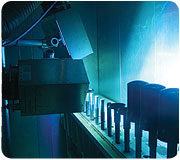
Coatings on oil filters are cured with UV technology. Photo courtesy of Strathmore Products, Inc.
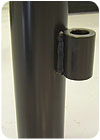
A 100% solids UV coating on a hydraulic cylinder. Photo courtesy of Strathmore Products, Inc.
Ultraviolet (UV) curing technology is being chosen at an increasing rate to meet these challenges and improve profitability through lower initial costs and operational expenses while increasing throughput and first-time-quality. Not only does UV technology offer direct savings, but it also permits the development and adoption of new techniques and finishing concepts, such as cellular finishing, that were not economically viable with more traditional finishing technology.
It has been difficult to implement a cellular finishing concept economically. In the case of thermal systems, it is well known that the best economies are achieved through large finishing systems. Line density - specifically in the oven - is the primary driver. The most efficient oven arrangements are those that minimize the surface-area-to-volume ratio. Heat losses occur through oven openings, roof, walls and the floor. By increasing the volume, you decrease the relative heat losses. With UV curing technology, openings and enclosure surface area have no effect. The primary challenge is to provide adequate space between the parts and have the parts arranged/oriented in a way that maximizes the UV energy exposure to cure the coating with the minimum number of lamps.
The earliest and widest adoption for UV-cured technology was in web-based or flat-line applications due to the ease with which the coating is exposed to minimum UV energy to achieve cure. Many of the early applications were limited to clearcoats or thin pigmented coatings used in operations such as printing, where performance requirements were minimal but high processing speeds were desired. Over the decades, advances in raw materials, UV equipment and manufacturing processes have resulted in adoption by industrial coating applications for three-dimensional (3D) parts, including direct-to-metal (DTM) applications.
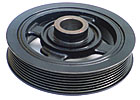
A 100% solids UV coating on a metal pulley. Photo courtesy of Allied PhotoChemical, Inc.
Formulating Concerns
A fundamental difference between traditional thermal coatings and UV coatings is the strong interdependency between the curing conditions and the formulation. The UV emission source (lamp) is a critical component of the formulation. Three important aspects must be considered by the formulator regarding the optical properties of a coating - 1) getting the UV energy to the substrate to achieve full coating cure, 2) minimizing competition or interference of the UV energy with other noncuring components of the formulation and 3) maximizing the absorption of UV energy by the photoinitiator. Pigments and other constituents absorb some of the UV energy, making through-cure a challenge.Several key raw material developments have helped significantly, including photoinitiators that absorb in the longer UV wavelengths, hyperbranched oligimers and nanomaterials. Photoinitiators that absorb in the longer wavelengths minimize the competition of energy with the pigments in the coating. It also has been known for years that longer UV wavelengths penetrate deeper into pigmented coatings. Hyperbranched oligomers and monomers achieve a high crosslink density with a minimum of shrinkage, maximizing adhesion to the substrate and increasing corrosion resistance. A review of product literature and patents also shows that the use of nanoparticles improves coating performance with minimal interference with the UV energy employed for curing.
Applications
The applications of UV technology in metal finishing vary widely from shafts and cylinders to complex shapes, such as portable propane gas cylinders, hydraulic cylinders, motor assemblies, oil filters, and underhood automotive parts such as damper pulleys. Of course, not all applications are candidates for UV curing. Asking several key questions can help determine whether processes lend themselves to UV:- Are the part surfaces easy to illuminate? The critical element here is the shadow areas on the part and its complexity. Parts that are convex in nature and with few or small appendages are ideal.
- Is there a large variation in the parts to be cured? The most cost-effective solutions are those with a minimum of variation. Typically, if two of the three dimensions have low variation, then there is a high probability of success.
- Are the color options limited? If a wide variety of colors are used, then providing the best UV spectrum might be difficult.
- How does the UV process fit with upstream and downstream processes? Matching productivity with cells before and after UV curing is a primary concern. If the finishing/curing of the coating is a bottleneck in your operations, then UV curing has to be a key technology candidate.
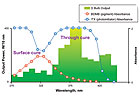
Figure 1.Dark or black coatings commonly are cured with a single D bulb.
UV Process Considerations
When designing the UV curing process, the primary concern is how the optics of the lamp relate to the geometry of the part to provide the UV energy required by the curing process window. Though this may be a complex problem, a number of standard solutions are used. They can be broken down into the following groups:- Multiple arrays of UV lamps. This is the most common and most flexible solution. The lamp array usually is designed to provide UV energy to a defined part window.
- Single lamp or one array of multiple lamps. This solution is used for simple shapes or for one- or two-dimensional substrates.
- Automation of the lamp(s). This can be as simple as a lamp or an array of lamps rotating on an axis or moving in a single plane, or as complex as a UV lamp mounted on a robot.
- Movement of the part. Lamps usually are fixed.
- Hybrid systems. Hybrid systems use a combination of fixed lamps with lamps that have some movement.
Single bulbs for pigmented systems most commonly use a D bulb. This type of cure is relatively common with dark or black coatings and is demonstrated in Figure 1.

Figure 2. Long-wavelength D, V and Q bulbs more easily penetrate coatings and are used to achieve through-cure, while the shorter-wavelength exposures of H bulbs enhance surface cure.
A critical aspect of the UV process is cleanliness. The UV system is an optical system, and contamination of the lamp system must be minimized to maintain the peak output and a consistent UV output. Ensuring cleanliness can be a challenge in an environment where metalworking lubricants and general shop dust particles are prevalent. Consideration of the air handling needs such as filtration, air source (outside is preferred) and cooling exhaust is crucial in the process design. Isolating the cooling air from the shop environment is strongly encouraged.
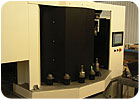
Figure 3. This four-walled finishing cell has self-contained spray application, air handling, liquid handling and UV curing. Image courtesy of Lesco – A Division of AUV.
Cellular Finishing
Manufacturing operations increasingly have been adopting cellular manufacturing techniques to maximize productivity and minimize waste by linking manual and machine operations. Process balancing is a key consideration. In the case of finishing, the idea is to have smaller finishing lines in the same scale as other manufacturing operations, such as molding. UV technology allows much smaller finishing systems to be used.Figures 3 and 4 show an example of a four-walled finishing cell with an internal turntable that indexes from station to station. The unit has self-contained spray application, air handling, liquid handling and UV curing. The size varies depending on the part envelope; in this case, the cell is approximately 8 x 8 x 8 ft. In one station, the parts are loaded and unloaded. The second station is where the coating is applied, and the part then indexes to the UV curing station.

Figure 4. Each part is presented to the UV curing lamps in the finishing cell, and the lamps have the ability to scan up and down as the part rotates to accommodate parts of varying height. Image courtesy of Lesco – A Division of AUV.
Another key advantage to UV curing in cellular manufacturing is that products can be finished with temperature-sensitive components such as seals, gaskets, and plastic components already on the part. In most cases, the finishing step can become the last step of the assembled product prior to packing.
Performance Specifications
One of the recent major achievements has been the success of formulators to meet the corrosion and appearance requirements for a variety of substrates, such as untreated and phosphate-treated steel, galvanized steel, and aluminum. All of these applications must meet aesthetic requirements, but the primary performance requirement is corrosion resistance. A typical requirement for corrosion resistance is salt fog resistance (ASTM MB117) of 250 to 1,000 hours. DTM UV coatings are available that meet these requirements.Another advantage of a UV-cured coating is that 100% of the properties are achieved upon cure. UV coatings are usually harder and cooler after curing, making the part ready for packing and shipping significantly faster.
The typical film thickness ranges from 0.5 to 2.0 mils. Film thickness control is a critical process parameter for UV coatings, making it highly desirable to automate the application process. With UV coatings, the thicker the coating, the more UV energy usually is required to maintain productivity.
Proven Technology
More than 20 years ago, UV coatings were starting to be adopted by the metal tube and pipe industry. Over the same timeframe, UV-cured coatings on 3D plastic parts have become commonplace, demonstrating that proven UV process solutions have been developed. The success of UV technology in these market sectors, coupled with the recent advances in raw materials, is accelerating the development of DTM coatings that meet market and customer performance requirements that a few years ago were deemed too difficult. With continued developments and cooperation among the stakeholders, the growth of the DTM application is very promising.For more information about UV curing, visit www.fusionuv.com.
Author's Acknowledgements
The author would like to thank the following companies for providing information, photos or graphics for this article:- Allied PhotoChemical Inc.
- Finishing Technology Solutions, LLC
- Lesco – A Division of AUV
- Mid-America Protective Coatings
- Rexcel Coatings Corp.
- Strathmore Products, Inc.

Report Abusive Comment